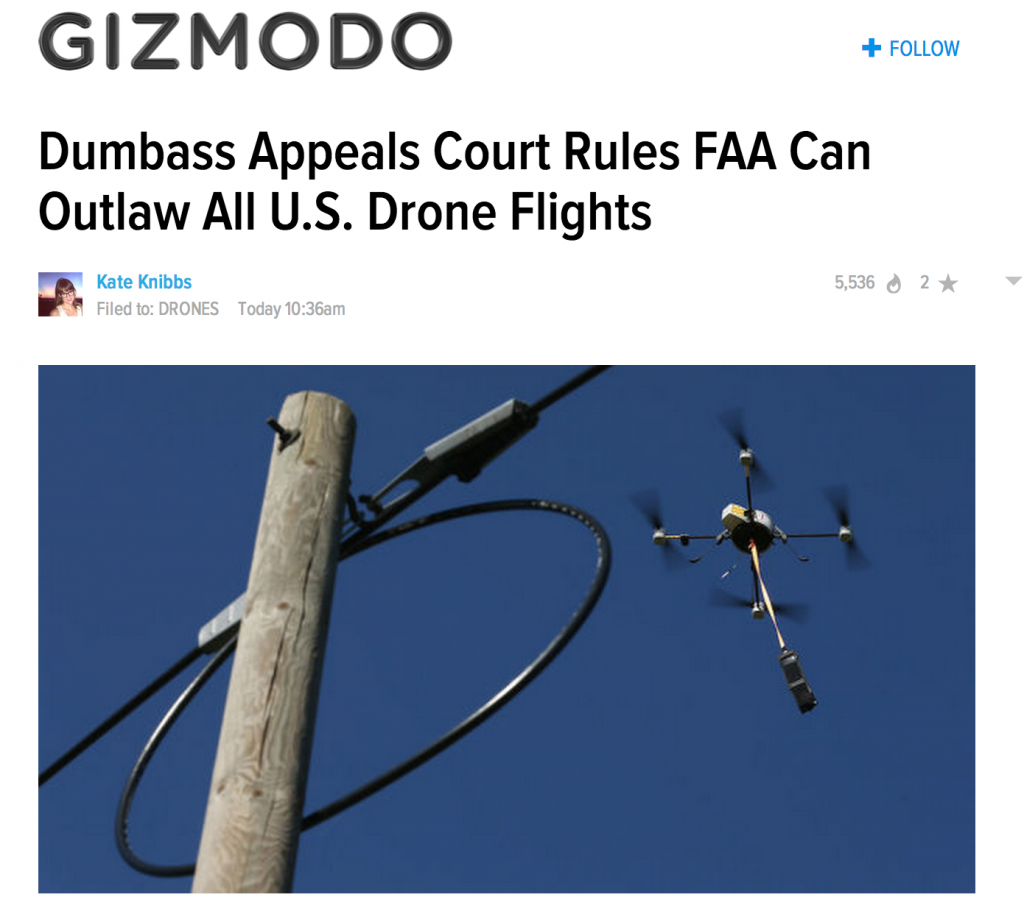Plenty of buzz has been building around the projected numbers of drones that will be flying off store shelves this holiday season. As if on cue, the feds have kicked the metaphorical door down in an attempt to make you think twice before you launch your drone.
On Tuesday morning, the National Transportation Safety Board announced its opinion and order in the infamous Raphael Pirker case stating that the FAA’s so-called regulations apply to small drones and that the administration could enforce penalties against commercial drone pilots who fly recklessly. An administrative judge dismissed the FAA’s case against Pirker this summer (which included a $10,000 fine), saying the lack of concrete rules gave the FAA no authority to enforce such a penalty. The NTSB has now remanded the case to the judge to collect evidence and determine whether or not Pirker was, in fact, flying recklessly.
You can read the NTSB’s opinion and order here, but what all the legalese essentially means is the FAA can fine anyone who flies an ‘aircraft’ in a manner they deem ‘reckless’- An ‘aircraft’ being “any device used for flight in the air” and ‘reckless’ being “a manner so as to endanger the life or property of another.”
Public reaction has been… less than enthusiastic:
The Federal Government Thinks Your Backyard Is National Airspace And Toys Are Subject To FAA Regulations http://t.co/EMOlijZ45Q
— Greg McNeal (@GregoryMcNeal) November 18, 2014
The FAA can fine you $10,000 for flying a drone anytime, anywhere thanks to a new court decision http://t.co/34XNPPMpCl — Jason Koebler (@jason_koebler) November 18, 2014
According to the NTSB, it is now possible to fly this “aircraft” recklessly. pic.twitter.com/LDJaR1z2Tc
— Peter Sachs, Esq. (@TheDroneGuy) November 18, 2014
Here is the kicker though: The decision made its first splash on the internet mere minutes before FAA’s Jim Williams took the podium at the UAS Commercialization Conference to address a room full of people who were at best, irritated with the FAA’s painfully slow progress in publishing regulations for UAS and at worst, flying anyway- in direct violation of the FAA’s policy.
The first thing Mr. Williams said was he hadn’t had time to read the opinion and order and therefore had no comment. He then spent the next 45 minutes exacerbating the crowd’s frustration.
Some of the ‘high’lights of Williams’ presentation:
- The FAA will publish a proposed rule for UAS by the end of the year which will be followed by an 18-20 month comment period. Meaning an official rule is at least two years away.
- As soon as an aircraft is -in any way shape or form- not on the ground, it falls under the FAA’s jurisdiction.
- If it seems illogical that anyone can buy a drone and fly full speed around your neighborhood as a hobbyist but you can’t hire someone to fly a drone at your wedding, you’re not wrong. But Congress and the law has locked the FAA into this Lemarchand’s box.
Mr. Williams was very polite and answered many questions from the crowd but offered little in the way of reassurance or concrete progress.
As a result, the general attitude among the attendees of the UAS Commercialization Conference seemed to be a deafening multitude of sighs and eye rolls.
Before Mr. Williams took his leave for the afternoon, I asked him my burning question: I get at least two emails a day about new professional aerial photography companies. What would he say to these people who are buying drones and starting businesses, on a daily basis?
His answer: Apply for a Section 333 exemption (the legislation that allows the FAA to grant exceptions on a case-by-case basis to commercial drone activities and has been granted exclusively to Conocophillips, BP, and Hollywood) so you don’t run into any trouble.
But the pervading answer among the conference’s attendees, both spoken and unspoken, seems to simply be: Don’t get caught.
Alan is serial entrepreneur, active angel investor, and a drone enthusiast. He co-founded DRONELIFE.com to address the emerging commercial market for drones and drone technology. Prior to DRONELIFE.com, Alan co-founded Where.com, ThinkingScreen Media, and Nurse.com. Recently, Alan has co-founded Crowditz.com, a leader in Equity Crowdfunding Data, Analytics, and Insights. Alan can be reached at alan(at)dronelife.com








Leave a Reply